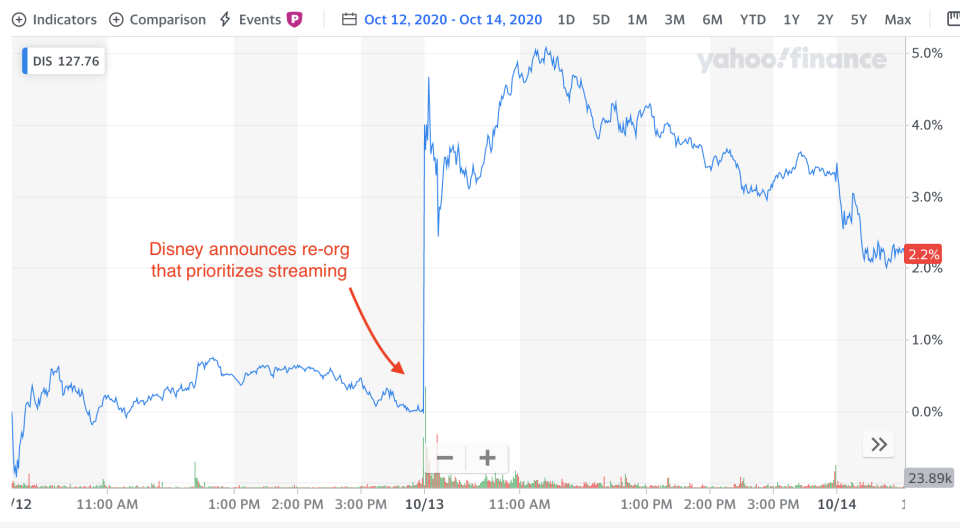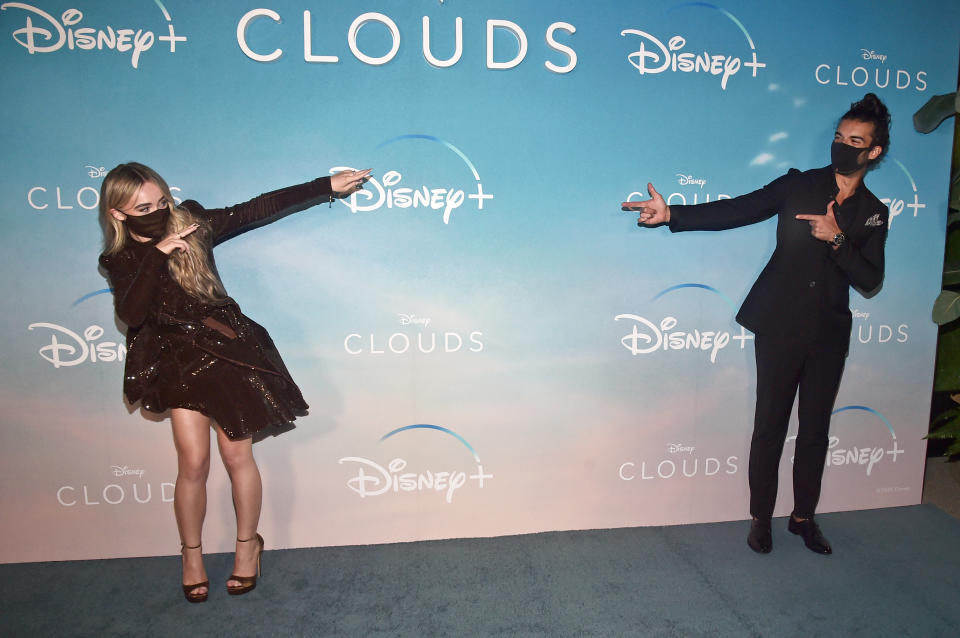Disney's streaming re-org is not just about Disney+
It’s not always the case that something as unsexy as an internal reorganization sends a stock higher. But Disney (DIS) on Monday announced a reorganization that sent its shares up more than 5% after hours.
The company has streamlined its many parts into two groups: Parks and Experiences, led by Josh D’Amaro; and Media and Entertainment Distribution, which will house the rest of the company and handle all creation, distribution and monetization of content, all overseen by Kareem Daniel.
The heads of the three main content divisions will remain the same (Alan Horn and Alan Bergman running studios, Jimmy Pitaro running sports, and Peter Rice running general entertainment) and will report to CEO Bob Chapek; Rebecca Campbell will run Disney’s streaming services but will now report to Kareem Daniel. Bob Iger, the former CEO who is now executive chairman, will continue to direct the creative pipeline.
What it all adds up to is an overt and public confirmation of what was already clear, and what Bob Iger said back in February 2019: Streaming is the top priority of the Walt Disney Company.
But streaming at Disney entails a lot more than just Disney+, its newest and glitziest product.

While the pandemic has been very good to Disney+, which amassed 60.5 million paying subscribers by August 2020, Disney also has Hulu (35.5 million subscribers), which it made the home of all FX shows, and ESPN+ (7.9 million subscribers), which has grown at a steady pace thanks mostly to soccer, MMA, and documentary content.
That’s more than 100 million subscribers across Disney’s streaming products.
Netflix is nearing 200 million subscribers globally, with 75 million of them in the U.S. Amazon Prime has more than 150 million subscribers, but it’s been reported that fewer than half use Prime Video.
So in only two years, Disney has become one of the top three competitors in streaming content. (ESPN+ launched in April 2018, Disney+ launched in November 2019, and Disney took full control of Hulu in May 2019 after an agreement with Comcast.)

More content will go direct to Disney streaming platforms
The implication of the reorg is that all three of Disney’s platforms are about to start getting a lot more direct content, a trend accelerated by the pandemic’s brutal hit to movie theaters. The success of “Hamilton” on Disney+ showcases that, along with Disney’s recent decisions to send “Mulan” and Pixar’s “Soul” straight to Disney+. (It hasn’t said what it will do with Marvel’s “Black Widow.”)
Disney+ launched at just the right time (a lucky accident), right before a global pandemic that shut down theaters and live performances and drove people toward at-home, on-the-couch viewing options. In contrast, Quibi, a new streaming app for on-the-go content meant to be viewed on your phone, launched at just the wrong time.
Under Disney’s new structure, content creation units will continue to create original content; the distribution and monetization folks will decide where the content will go, and will likely send a lot more content straight to streaming rather than to linear cable or movie theaters. (LiveMint reports that Disney plans to do the same in India: cut back on its TV broadcasting and film studio businesses there to focus on creating content for streaming services.)
“We celebrate the recent reorganization announcement,” says Jason Ware, chief investment officer at Albion Financial Group, “because we think it puts a dedicated focus on what the growth story for Disney is, and that is their streaming services.”
Disney actually outspends Netflix on content
A note on Tuesday from Credit Suisse, which has an Outperform rating on the stock and a price target of $146 (it opened at $129 on Wednesday), makes it clear why Wall Street loves the reorg.
Disney quietly spends more than Netflix (NFLX) on content, Credit Suisse points out, and is about to start spending even more—and that’s a good thing.
“We believe company-wide Disney spends more on content than investors might realize [$27 billion in 2020; $18 billion if you subtract news and sports], and, while not apples-to-apples, more than Netflix [$13 billion in 2020],” writes Credit Suisse. “We expect Disney's overall general entertainment spending of ~$18 billion per year across internal production, library, and third parties will increasingly shift to streaming (and will grow). While not the focus of the reorg, we expect overhead savings as a result. We see this move as a significant positive for Disney.”
Despite all the media attention on Disney+, the shiny new toy, only an estimated $2.7 billion of Disney’s $18 billion in content spend in 2020 is on Disney+, according to Credit Suisse. That spend will increase, since the Disney+ original content slate for 2021 and 2022 includes a slew of highly-anticipated Avengers and Star Wars spin-off shows like “The Falcon and the Winter Soldier,” “WandaVision,” and the as-yet-untitled Ewan McGregor Obi-Wan Kenobi series.
Over on Hulu, which Disney has made its home for more adult content, FX’s new season of “Fargo,” starring Chris Rock, is grabbing a lot of attention. On ESPN+, out-of-market MLS games, MMA fights, and a handful of original sports studio shows have established the app as a must-have for fans of niche sports.
Since July 6, when Nielsen began tracking Disney+ viewership, Disney+ and Hulu have combined for 16% of all streaming minutes in the U.S., second only to YouTube (19.6%) and Netflix (32%).
And of course, Disney could still build out another streaming product; it won’t necessarily stop at the three it has.
—
Daniel Roberts is an editor-at-large at Yahoo Finance and closely covers the streaming wars. Follow him on Twitter at @readDanwrite.
Read more:
Disney, WB are sending a clear signal: Americans aren't ready to return to movie theaters
Disney’s $30 ‘Mulan’ plan will be a litmus test for the entire film industry
‘Hamilton’ delivers 64% download bump for Disney+
Disney's 'Mulan' will look to Christopher Nolan's 'Tenet' for a movie theater health check
Coronavirus is forcing Quibi, NBC Peacock to change their plans at launch
Movie theaters seek bailout as coronavirus devastates business
